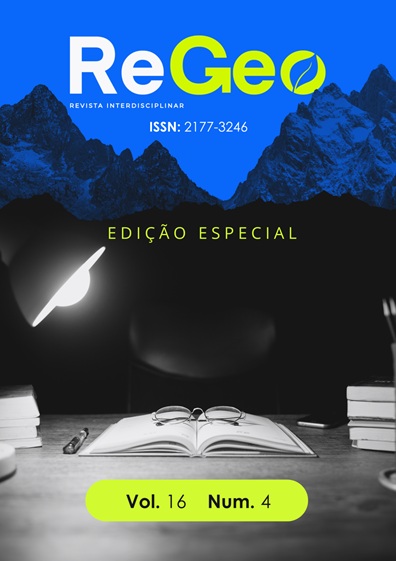ETHNOPHARMACOLOGICAL USE OF BOLDO (PLECTRANTHUS NEOCHILUS) IN THE MANAGEMENT OF GASTROINTESTINAL DISEASES IN BACURITEUA, (PARÁ)
DOI:
https://doi.org/10.56238/revgeov16n4-055Keywords:
Plectranthus neochilus, Bioactive Compounds, HepatoprotectionAbstract
Medicinal plants possess bioactive compounds with therapeutic properties and great relevance in traditional medicine. This study analyzed the use of Plectranthus neochilus (boldo) in the community of Bacuriteua, Pará, and its effects recorded in the scientific literature. The species is used to treat liver and digestive disorders through a decoction of green leaves, ingested orally for three to seven days. Additional studies have identified phenolic and terpenoid compounds with antioxidant, anti-inflammatory, and hepatoprotective properties. In vivo assays also indicate antimicrobial and antischistosomal activity, with low toxicity at controlled doses. The conclusion is that the traditional use of the species is scientifically supported, reinforcing its potential as a phytotherapeutic resource.
Downloads
References
AGUIAR ET AL., 2018; Baldin et al., 2012; Bandeira et al., 2011; Caixeta et al., 2011; Crevlin et al., 2015; Medeiros et al., 2016.
AGUIAR, G. P. et al. Antifungal Activity of the essential oils of Plectranthus neochilus (Lamiaceae) and Tagetes erecta (Asteraceae) cultivated in Brazil. Internationa Journal of Complementary & Alternative Medicine, v. 1, n. 1, p. 31–35, 2018ª
BALDIN, E. L. L. et al. Plant-derived essential oils affecting settlement and oviposition of Bemisia tabaci (Genn.) biotype B on tomato. Journal of Pest Science, v. 86, n. 2, p. 301– 308, 2013.
BRASIL. Ministério da Saúde. Secretaria de Ciência, Tecnologia e Insumos Estratégicos. Departamento de Assistência Farmacêutica. Decreto nº 5.813, de 22 de junho de 2006.
CAIXETA, S. C. et al. Chemical composition and in vitro schistosomicidal activity of the essential oil of plectranthus neochilus grown in Southeast Brazil. Chemistry and Biodiversity, v. 8, n. 11, p. 2149–2157, 2011.
CAMARGO, L. E. A. et al. Antioxidant and antifungal activities of Camellia sinensis (L.) Kuntze leaves obtained by different forms of production. Brazilian Journal of Biology, v. 76, n. 2, p. 428–434, 15 mar. 2016.
CHANDRASEKARA, A.; SHAHIDI, F. Herbal beverages: Bioactive compounds and their role 149 in disease risk reduction - A review. Journal of Traditional and Complementary Medicine, v. 8, n. 4, p. 451–458, 2018.
COLCHESTER´M, Resgantando a natureza: Comunidade Tradicionais e área protegidas in. DIEGUES A.C. Etnoconservação: novos ramos para proteção da natureza nos trópicos- São Paulo: Hucitec 2000.
CREVELIN, E. J. et al. Antimicrobial Activity of the Essential Oil of Plectranthus neochilus against Cariogenic Bacteria. Evidence-based Complementary and Alternative Medicine, v. 2015, p. 9–11, 2015.
DE LA ROSA, L. A. et al. Phenolic compounds. [s.l.] Elsevier Inc., 2018.
DIEGUES, A. C. A construção da etno-conservação no Brasil: o desafio de novos conhecimentos e novas práticas para a conservação. São Paulo: NUPAUB, 2010
FANELA, T. L. M. et al. Lethal and Inhibitory Activities of Plant-Derived Essential Oils Against Bemisia tabaci Gennadius (Hemiptera: Aleyrodidae) Biotype B in Tomato. Neotropical Entomology, v. 45, n. 2, p. 201–210, 2016
GALBIATTI, M. I. et al. Plectranthus neochilus Schltr.: Anatomic and cytogenetic analyses and chemical characterization of its essential oil. South African Journal of Botany, v. 143, p. 97–106, 1 dez. 2021.
GOMES, L.M.A.; Andrade, T.M.D.; Silva, J.C.; Lima, J. T.; Quintans-Junior, L.J.; Almeida, J.R.G.S. 2014. A. Phytochemical screening and anti-inflammatory activity of Cnidoscolus quercifolius (Euphorbiaceae) in mice. Pharmacognosy Research. 6: 345- 349, 2014
LAWAL, O. A.; HUTCHINGS, A. H.; OYEDEJI, O. Chemical composition of the leaf oil of plectranthus neochilus schltr. Journal of Essential Oil Research, v. 22, n. 6, p. 546–547, 2010.
LORENZI, H. & Matos, F.J. A. Plantas Medicinais no Brasil Nativas e Exóticas, 2002.
MARAVAI, S. G et al. Plantas medicinais: percepção, utilização e indicações terapêuticas de usuários da estratégia saúde da família do município de CriciúmaSC vinculados ao PET- Saúde. Arquivos Catarinenses de Medicina, v. 40, n. 4, p. 69-75, 2011.
MARTINS, E.R. ets al. Plantas Medicinais.s.l:s.n.2016.
PEREIRA, M. et al. Antimicrobial screening of Plectranthus madagascariensis and P. neochilusextracts. Journal Biomedical and Biopharmaceutical Research, v. 12, n. 1, p. 127–138, 2015
RAJA, R. R. Medicinally potential plants of Labiatae (Lamiaceae) family: An overview. 2012
RAMBORGER, B. P. et al. The phytoremediation potential of Plectranthus neochilus on 2,4- dichlorophenoxyacetic acid and the role of antioxidant capacity in herbicide tolerance. Chemosphere, v. 188, p. 231–240, 2017b.
RBG, K. The state of the world’s plants report. [s.l: s.n.]. Disponível em: . Acesso em: 5 mar. 202. 2017.
RICE LJ, BRITS GJ, POTGIETER CJ, VAN STADEN J. Plectranthus: a plant for the future? South African Journal of Botany. 2011; 77, 947–959. https://doi.org/10.1016/j.sajb.2011.07.001.
SILVA, I. R.; OLIVEIRA, E; LIMA, R.M.R.; RODRIGUES, E.M.S.; BLANDTT, L.S. Desafios da taxonomia e terminologia de plantas medicinais. In: Estudos Antrópicos na Amazônia: Colaborações em Pesquisas Interdisciplinares. V. 03., n 1, 169-182, 2025.
TAIZ, L.; ZEIGER, E. Plant Physiology. [s.l.] Cambridge University Press, 2002. v. 34.
VIANA, A. J. S. Estudo químico e de atividade biológica DE Plectranthus neochilus Schltr. Lamiaceae)(128 p.).[Chemical and Biological Activity Study DE Plectranthus neochilus Schltr.(Lamiaceae).] Dissertação de Mestrado, Diamantina: Universidade Federal dos Vales do Jequitinhonha e Mucuri, 2011.
WFO Plectranthus neochilus. World Flora Online, 2025. Disponível em: http://www.worldfloraonline.org/taxon/wfo-0001319475. Acesso em: 22 fev. 2025.


